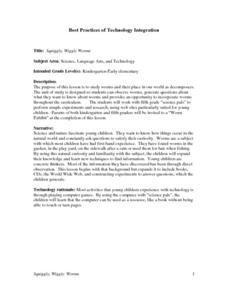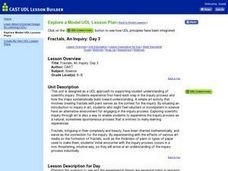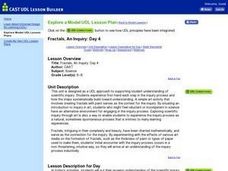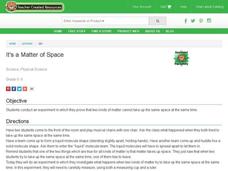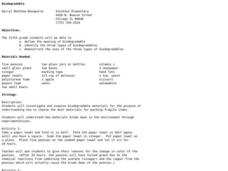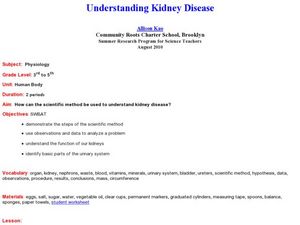Curated OER
Bacteria: The good, the bad, the ugly
Seventh graders conduct an experiment. In this bacteria instructional activity, 7th graders list living and nonliving things and brainstorm the characteristics they share. Students are divided into two groups where they put...
Curated OER
Food Safety Lab-Part 3 Cross Contamination andHygiene
Students observe the effect of croos contamination as they inoculate orange juice with penicillin mold from the refrigeration lab and active yeast solution from the sterilization lab. They experience a simulation of passing bacteria...
Reach Out!
Paper Clip Sailing
Students explore water, molecules, and surface tension. In this floatation lesson, students discover why some objects are able to float on water as they follow the procedures included in this activity.
Curated OER
How Hot Is Hot In Namib?
Students research and demonstrate the temperatures of the Namibian Desert. They watch and discuss a video, conduct an experiment to demonstrate the desert temperatures, record their results in the form of a graph, and compare/contrast...
Curated OER
Squiggly, Wiggly Worms
Students, who are in early elementary grades, pair with fifth grade students to study worms. They observe worms in experiments, create research questions, and complete the research using Internet sites. They participate in a "Worm...
Curated OER
DEMONSTRATING AN EPIDEMIC
Students experience a small scale "epidemic," demonstrating the ease with which disease organisms are spread, and enables the student to determine the originator of the "epidemic." They transfer live bacteria by hand contact, then...
Curated OER
Change It
Fourth graders expand their knowledge about how the physical properties of a substances can be changed. They are given multiple opportunities, using first-hand experiences and familiar objects in different contexts, to identify...
Curated OER
Now you see it....Now you Don't
Students investigate the biodegrading process of packing peanuts. In this biological process lesson, students conduct an experiment to see how quickly packing peanuts biodegrade. Students check the process each day and record their results.
Curated OER
Salt: Up Close and Personal
Learners predict, observe, and explain the details of salt as they view it under a variety of magnifications. They observe salt with the naked eye, and then under a hand lens, microscope, and the electron microscope.
Curated OER
Going, Going, Gone!
Sixth graders use the scientific method to test variables of evaporation. In this evaporation lesson plan, 6th graders test a wet handprint on a paper towel and relate this experiment to weather conditions.
Curated OER
Fractals, An Inquiry: Day 3
Students develop questions for their inquiries and plan their experiments. They are supported by a modeled case study of Max the Dog's Inquiry Planning Process, as well as supported by a planning template, The Inquiry Organizer.
Curated OER
Fractals, An Inquiry: Day 4
Students put their growing understanding of the scientific inquiry process to work. They use paint to implement their plans to experiment with how changing one aspect of the fractal making process influences their appearance.
Curated OER
Polymers-Greaaaaaat Biiiiiig Molecuuuuuules
Students explore polymer properties. In this lesson about polymers, students perform an experiment to understand polymers, their properties, and that they are formed from small molecules. Students role play pretending they are polymer...
Curated OER
It's a Matter of Space
Students explore matter. In this physical science lesson, students role play the 3 states of matter forming "liquid" molecules and "solid" molecules with teammates. Students perform an experiment in which the result illustrates that two...
Curated OER
Whale Blubber
Students examine the purpose and characteristics of whale blubber. They work together to complete an experiment to test the fat as an insulator. They discover how humans use materials to protect them from the cold.
Curated OER
Reuse, Reduce, Recycle Paper
Students experiment with recycling paper. For this paper recycling lesson, students conduct an experiment in which they dissolve newspaper in water and cornstarch to make new pieces of paper. They add color or flowers to the new paper to...
Curated OER
What is a Seed?
First graders identify the parts of a seed. In this plant biology instructional activity, 1st graders are given a seed and identify each part of the seed by using a hand lens. Students plant a seed and graph the growth.
Curated OER
Billions of Bubbles
Students conduct an experiment with bubbles. In this observation and comparison instructional activity, students read Bubbles, Bubbles, Everywhere and conduct an experiment where they test different kinds of liquids to see which is...
Curated OER
Rules of Force and Motion
Students view a video and complete experiments with force and motion. In this force and motion instructional activity, students examine small pieces and how they affect the motion of a toy car. Students also experiment with...
Curated OER
Weathering and Erosion
Students perform experiments to simulate weathering and erosion. In this earth science lesson, students view a PowerPoint presentation that includes weathering, erosion, and the Dust Bowl. Students conduct a series of experiments to...
Curated OER
Diffusion
Students design and carry out an experiment according to the scientific method. The experiment must test the effects of time and concentration on the rate of diffusion of potassium permanganate into potato cubes. After performing the...
Curated OER
Biodegradable
Fifth graders experiment with biodegradable materials. In this science lesson, 5th graders perform a series of experiments, then discuss and chart their observations. Through the experiments, students will be able to identify three types...
Curated OER
Understanding Kidney Disease
Students experiment to determine information about kidney function. In this kidney function activity, students use the scientific method to experiment with eggs, water, salt, sugar, and vegetable oil to simulate kidney function. They...
Curated OER
Disposable Diaper Comparison and Mystery Powder Identification
Students investigate which diaper is the most absorbent. In this chemistry lesson, students calculate how much water is absorbed by diapers. They identify an unknown powder based on physical and chemical properties.




